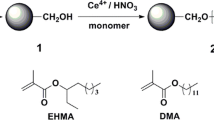Abstract
The influence of dispersing additives on the electrical conductivity of carbon black pigments dispersed in an organic medium was studied. Two dispersing additives were examined in combination with two different carbon blacks, a conductive carbon black and a nonconductive one. These carbon blacks differ in the size of their aggregates and in the amounts of surface oxygen groups. Both of the additives form a monolayer when adsorbed on either of the pigment surfaces. FTIR studies showed that chemical bonding of one of the additives on the surfaces of both pigments had occurred. Conductivity decreases with increasing additive concentration, but in the case of the chemically bonded additive, the conductivity of the dispersion remained high even at higher additive loadings. This study helps in understanding the effects such additives have on the specific conductivity of composite materials that contain dispersed carbon black pigment particles.






Similar content being viewed by others

References
Donnet, JB, Bansal, RC, Wang, MJ, Carbon Black Science and Technology. Marcel Dekker, New York (1993)
Balberg, I, “A Comprehensive Picture of the Electrical Phenomena in Carbon Black–Polymer Composites.” Carbon, 40 (2) 139–143 (2002)
El-Tantawy, F, Kamada, K, Ohnabe, H, “Electrical Properties and Stability of Epoxy Reinforced Carbon Black Composites.” Mater. Lett., 57 (1) 242–251 (2002)
Salmi, A, Benfarhi, S, Donnet, JB, Decker, C, “Synthesis of Carbon–Polyacrylate Nanocomposite Materials by Crosslinking Polymerization.” Eur. Polym. J., 42 (9) 1966–1974 (2006)
Zhang, W, Dehghani-Sanij, AA, Blackburn, RS, “Carbon Based Conductive Polymer Composites.” J. Mater. Sci., 42 (10) 3408–3418 (2007)
Hauptman, N, Žveglič, M, Maček, M, Klanjšek Gunde, M, “Carbon Based Conductive Photoresist.” J. Mater. Sci., 44 (17) 4625–4632 (2009)
Fujitani, T, “Stability of Pigment and Resin Dispersions in Waterborne Paint.” Prog. Org. Coat., 29 (1–4) 97–105 (1996)
Nsib, F, Ayed, N, Chevalier, Y, “Selection of Dispersants for the Dispersion of Carbon Black in Organic Medium.” Prog. Org. Coat., 55 (4) 303–310 (2006)
Ridaoui, H, Jada, A, Vidal, L, Donnet, JB, “Effect of Cationic Surfactant and Block Copolymer on Carbon Black Particle Surface Charge and Size.” Colloids Surf. A, 278 (1–3) 149–159 (2006)
Li, D, Sun, G, “Coloration of Textiles with Self-Dispersable Carbon Black Nanoparticles.” Dyes Pigm., 72 (2) 144–149 (2007)
Wu, SH, Pendleton, P, “Adsorption of Anionic Surfactant by Activated Carbon: Effect of Surface Chemistry, Ionic Strength, and Hydrophobicity.” J. Colloid Interface Sci., 243 (2) 306–315 (2001)
Lin, Y, Smith, TW, Alexandridis, P, “Adsorption of a Polymeric Siloxane Surfactant on Carbon Black Particles Dispersed in Mixtures of Water with Polar Organic Solvents.” J. Colloid Interface Sci., 255 (1) 1–9 (2002)
Chen, X, Farber, M, Gao, Y, Kulaots, I, Suuberg, EM, Hurt, RH, “Mechanisms of Surfactant Adsorption on Non-Polar, Air-Oxidized and Ozone-Treated Carbon Surfaces.” Carbon, 41 (8) 1489–1500 (2003)
Moreno-Castilla, C, “Adsorption of Organic Molecules from Aqueous Solutions on Carbon Materials.” Carbon, 42 (1) 83–94 (2004)
Syed Azim, S, Satheesh, A, Ramu, KK, Ramu, S, Venkatachari, G, “Studies on Graphite Based Conductive Paint Coatings.” Prog. Org. Coat., 55 (1) 1–4 (2006)
Spinelli, HJ, “Polymeric Dispersants in Ink Jet Technology.” Adv. Mater., 10 (15) 1215–1218 (1998)
Kissa, E, Dispersions: Characterization, Testing, and Measurement. Marcel Dekker, New York (1999)
Adamson, AW, Gast, AP, Physical Chemistry of Surfaces. Wiley, New York (1997)
Somasundaran, P, Krisnakumar, S, “Adsorption of Surfactants and Polymers at the Solid–Liquid Interface.” Colloids Surf. A, 123–124 461–513 (1997)
Bulychev, N, Dirnberger, K, Arutunov, I, Kopold, P, Schauer, T, Zubov, V, Eishenbach, CD, “Effect of Ultrasonic Treatment on Structure and Properties of Ethylhydroxyethylcellulose Polymer Adsorption Layer on Inorganic Pigments in Aqueous Dispersion.” Prog. Org. Coat., 62 (3) 299–306 (2008)
Lux, F, “Models Proposed to Explain the Electrical Conductivity of Mixtures Made of Conductive and Insulating Materials.” J. Mater. Sci., 28 (2) 285–301 (1993)
Pugh, RJ, Matsunaga, T, Fowkes, FM, “The Dispersibility and Stability of Carbon Black in Media of Low Dielectric Constant. 1. Electrostatic and Steric Contributions to Colloidal Stability.” Colloids Surf., 7 183–207 (1983)
Pugh, RJ, Fowkes, FM, “The Dispersibility and Stability of Coal Particles in Hydrocarbon Media with a Polyisobutene Succinimide Dispersing Agent.” Colloids Surf., 11 423–427 (1984)
Smiechowski, MF, Lvovich, VF, “Characterization of Non-Aqueous Dispersion of Carbon Black Nanoparticles by Electrochemical Impedance Spectroscopy.” J. Electroanal. Chem., 577 67–78 (2005)
Xu, R, Wu, C, Xu, H, “Particle Size and Zeta Potential of Carbon Black in Liquid Media.” Carbon, 45 2806–2809 (2007)
Kozak, D, Moreton, D, Vincent, B, “The Adsorption of Non-Ionic Surfactants on Carbon Black Particles in Hydrocarbon Media.” Colloids Surf., A 347 245–250 (2009)
Colthup, NB, Daily, LH, Wiberley, SE, Introduction to Infrared and Raman Spectroscopy. Academic Press, Boston (1990)
Boehm, HP, “Surface Oxides on Carbon and Their Analysis: A Critical Assessment.” Carbon, 40 (2) 145–149 (2002)
Jäger, C, Henning, Th, Schlögl, R, Spillecke, O, “Spectral Properties of Carbon Black.” J. Non-Cryst. Solids, 258 (1–3) 161–179 (1999)
Acknowledgments
This research was supported by the Slovenian research Agency (Project No. J2-9455). Nina Hauptman acknowledges the Slovenian Research Agency for the young researchers support. The authors wish to thank Evonik-Degussa, Croatia who kindly provided the carbon black samples, and AIM Chemicals, Croatia for providing the dispersant samples.
Author information
Authors and Affiliations
Corresponding author
Rights and permissions
About this article
Cite this article
Hauptman, N., Klanjšek Gunde, M., Kunaver, M. et al. Influence of dispersing additives on the conductivity of carbon black pigment dispersion. J Coat Technol Res 8, 553–561 (2011). https://doi.org/10.1007/s11998-011-9330-5
Published:
Issue Date:
DOI: https://doi.org/10.1007/s11998-011-9330-5



